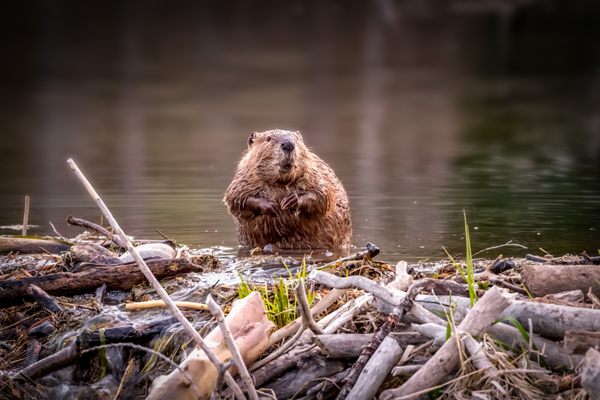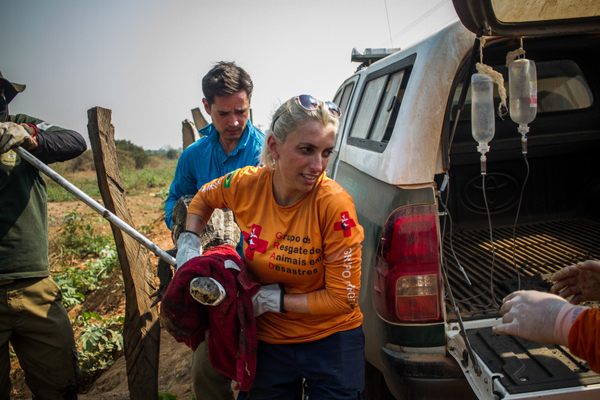How Does California’s Wildlife Cope With Massive Wildfires?
Researchers at the Santa Monica Mountains National Recreation Area are trying to better understand animal survival tactics.

One of the first animals to perceive a quickly spreading California wildfire may well be the mountain lion, whose keen sense of smell recognizes danger before the smoke starts to spread. And, like humans, the decision of whether or not to flee is a difficult one, stuck between the fear of fire and the uncertainty of leaving one’s home.
“I try to put myself in the mind of a mountain lion,” says Korinna Domingo, conservation specialist at the Mountain Lion Foundation, a wildlife conservation organization based in California. “How close does the fire have to be, and how high does the risk have to be for that lion to step over that line and leave?”
Like the human communities escaping fire and destruction across California, the state’s wild animals also have the instinct to flee. The question is, in a landscape covered in development and populated by millions of people, where can they go?
That’s one of the questions being asked by researchers and rangers at the Santa Monica Mountains National Recreation Area, part of which is currently burning in the Woolsey Fire—a Southern California blaze which has torched around 100,000 acres of residential and protected areas as of this morning. The National Recreation Area, run by the National Park Service, has been tracking dozens of mountain lions in the area since 2002 using GPS collars. And now, by a twist of fate, they have the opportunity to better understand how large mammals respond to wildfire.
“It’s become this unplanned experiment about what happens when you have an isolated protected area, and half of the habitat is eliminated by a fire,” says Seth Riley, Chief of Wildlife for the Santa Monica National Recreation Area. “This fire will provide a huge opportunity to see what various wildlife communities do in these extreme conditions.”

Mountain lions are territorial animals, and researchers are interested to know whether they will form the same boundaries when they return to their habitats. “A lot of the lions’ home ranges are right on top of each other in such a confined space in Santa Monica,” says Domingo. “It’ll be really interesting to see how those lions re-establish territories. The social structures may be completely disrupted.”
While many animals are indeed displaced by wildfires, it’s important to note that fire is not wholly bad for landscapes in an ecological sense. In fact, many California ecosystems rely on fire to thrive. “Fire in the human sense can often be catastrophic, but it’s not necessarily the same for animals,” says Greg Giusti, a retired University of California researcher and an expert on the relationship between wildfires and wildlife. He says California wildlife have evolved to respond to fires, and can even sometimes benefit from the disruption. “It’s harsh out there, but you know these animals have evolved to survive in that hostile environment.”
There are a variety to survival tactics that California wildlife will use, says Giusti. For example, birds are easily able to fly away and are usually not impacted as long as fires don’t occur during the spring when they are nesting and raising their offspring.
And if you can’t fly away, why not hunker down? Giusti says while it may be 1,600 degree Fahrenheit above ground as a fire rages through a landscape, two inches below the surface, the temperature can be as mild as 70 degrees, and many species, such as lizards, chipmunks, ground squirrels, and mice, survive fires by sticking it out in underground burrows.
For the non-flying, non-burrowing animals, including deer, mountain lions, and coyotes, the only choice is to run. Giusti says usually animals are successful when they flee on foot, but fast-moving fires like the Camp Fire currently raging in Northern California may be too fast and destructive for many animals. “The Camp Fire is being driven by incredibly strong winds and it’s creating an actual firestorm,” he says. “If you’re a two-legged animal like a human or a four-legged animal like a deer, these fires move so fast, sometimes you simply can’t outrun them.”

For the animals that are able to escape, they usually do come back, says Giusti. “There is pretty good precedent for animals returning back to where they came from.” He says newly burned landscapes are often good for new plant growth and feeding opportunities. For example, woodpeckers can be found feasting on the bugs who feed on burnt wood. Mice and California quail feed on newly exposed seeds on the ashen ground, and they are hunted by owls and hawks.
In the chaparral landscape, deer feed on a high-protein plant species, known as chamise. “As time passes from a fire, and we get a bit of rain, it’s amazing how fast a landscape can recover,” says Giusti.
Giusti says while people may feel tempted to feed and interact with animals fleeing wildfires, it’s important that people keep a distance. “It’s never good to invite wildlife to a property,” he says. “In the long run, it usually ends up in some kind of conflict and the animals are the ones that pay the price.”
While it’s a good thing to care deeply for our non-human neighbors, says Giusti, we must remember that they are resilient and have co-evolved with a harsh environment. In short: They got this.
“It’s not necessarily easy for them, but nature is not easy,” he says. “This is a tough deal, but these animals are survivors. They’re good at it.”













Follow us on Twitter to get the latest on the world's hidden wonders.
Like us on Facebook to get the latest on the world's hidden wonders.
Follow us on Twitter Like us on Facebook